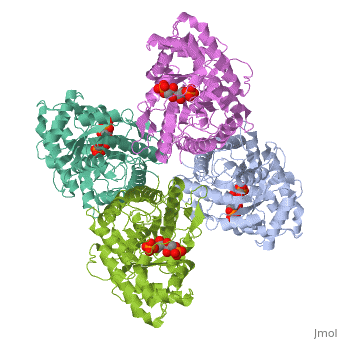| Structural highlights
Disease
ALDOA_HUMAN Defects in ALDOA are the cause of glycogen storage disease type 12 (GSD12) [MIM:611881; also known as red cell aldolase deficiency. A metabolic disorder associated with increased hepatic glycogen and hemolytic anemia. It may lead to myopathy with exercise intolerance and rhabdomyolysis.[1] [2] [3] [4] [5]
Function
ALDOA_HUMAN Plays a key role in glycolysis and gluconeogenesis. In addition, may also function as scaffolding protein (By similarity).
Evolutionary Conservation
Check, as determined by ConSurfDB. You may read the explanation of the method and the full data available from ConSurf.
See Also
References
- ↑ Esposito G, Vitagliano L, Costanzo P, Borrelli L, Barone R, Pavone L, Izzo P, Zagari A, Salvatore F. Human aldolase A natural mutants: relationship between flexibility of the C-terminal region and enzyme function. Biochem J. 2004 May 15;380(Pt 1):51-6. PMID:14766013 doi:10.1042/BJ20031941
- ↑ Kishi H, Mukai T, Hirono A, Fujii H, Miwa S, Hori K. Human aldolase A deficiency associated with a hemolytic anemia: thermolabile aldolase due to a single base mutation. Proc Natl Acad Sci U S A. 1987 Dec;84(23):8623-7. PMID:2825199
- ↑ Takasaki Y, Takahashi I, Mukai T, Hori K. Human aldolase A of a hemolytic anemia patient with Asp-128----Gly substitution: characteristics of an enzyme generated in E. coli transfected with the expression plasmid pHAAD128G. J Biochem. 1990 Aug;108(2):153-7. PMID:2229018
- ↑ Kreuder J, Borkhardt A, Repp R, Pekrun A, Gottsche B, Gottschalk U, Reichmann H, Schachenmayr W, Schlegel K, Lampert F. Brief report: inherited metabolic myopathy and hemolysis due to a mutation in aldolase A. N Engl J Med. 1996 Apr 25;334(17):1100-4. PMID:8598869 doi:http://dx.doi.org/10.1056/NEJM199604253341705
- ↑ Yao DC, Tolan DR, Murray MF, Harris DJ, Darras BT, Geva A, Neufeld EJ. Hemolytic anemia and severe rhabdomyolysis caused by compound heterozygous mutations of the gene for erythrocyte/muscle isozyme of aldolase, ALDOA(Arg303X/Cys338Tyr). Blood. 2004 Mar 15;103(6):2401-3. Epub 2003 Nov 13. PMID:14615364 doi:10.1182/blood-2003-09-3160
|


